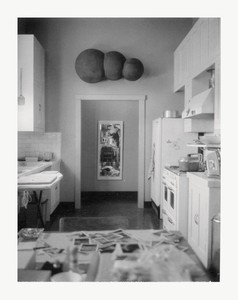
Robert Therrien: The Causal Link to the (Un)Real
In honor of the extraordinary life of Robert Therrien (1947–2019), Aimee Gabbard writes about her time with the artist and explores his lifelong interest in photography.
Sometimes people ask whether I am a romantic or a realist artist. I would hope that I fall between the two. . . The ideal artist looks at the future and the past at the same time. The romantic artist spends more time looking backwards. The realist attempts to work in the present but emphasizes the future. However, if you try to predict the future, you seldom succeed.
—Robert Therrien
Over the past four decades, Robert Therrien (1947–2019) cultivated an expansive vernacular of forms drawn from memory and the everyday. Seemingly simple subjects—including snowmen, bows, and oilcans—acquire multiple levels of reference and association, while outsized sculptures of stacks of plates, tables and chairs, and beards shift between the ordinary and the surreal. The repetitive perfecting of chosen motifs is central to his work, imbuing objects and images with intentionality and a latent sense of the unattainable.
Born in Chicago, Therrien emerged on the burgeoning Los Angeles art scene in the late 1970s after completing graduate school at the University of Southern California, Los Angeles, and studying photography at the Brooks Institute, Santa Barbara, California. At a time when the dominance of Minimalism and Conceptualism was being challenged, Therrien adopted certain formal aspects of these movements, yet allowed his pared-down sculptures and monochrome wall reliefs to take on poetic reference and implied narratives.
Therrien was represented by Leo Castelli in New York and Konrad Fischer in Düsseldorf throughout the 1980s and 1990s, during which time his work received increasing international recognition. In 1984 the Museum of Contemporary Art, Los Angeles, presented the first exhibition of his stand-alone rooms: six re-creations of his Pico Boulevard studio, complete with the artworks therein. The studio would continue to be a subject and conceptual catalyst throughout Therrien’s oeuvre, in which art and domestic life are deeply intertwined. In 1990 he moved to a two-story building that he designed and built according to the layout of the earlier Pico Boulevard studio. This space served as home, repository, workshop, and gallery, allowing Therrien to reference his past works as well as items from everyday life—taking them from two to three dimensions or from small- to large-scale and back again.
In 1991 the Museo Nacional Centro de Arte Reina Sofía, Madrid, presented a survey of Therrien’s work since 1969, revealing the evolution of many of his motifs as they vacillate between the familiar and the abstract. The exhibition included a sculpture comprised of three worn white cabinets, which simultaneously echo the seriality of Minimalist sculpture and the intimate tactility and history of found objects. In the early 2000s Therrien continued to reinvent his unique vocabulary, revealing influences including Surrealism, early Hollywood cartoons, childhood myths, and period-specific design. Survey exhibitions at the Los Angeles County Museum of Art (2011), the Albright-Knox Art Gallery, Buffalo, New York (2013), and Parasol unit, London (2016), revealed Therrien’s investigations of what he calls “figure-ground play,” wherein an image can evoke many things at once or seem to advance and retreat simultaneously. These chromatic and perspectival effects were expanded in his later room works, in which objects and spaces are reduced not in form but through choice of materials, monochromatic palettes, and presentation of either crowded or eerily sparse interiors.
Parallel to his sculpture practice, Therrien’s works on paper display the uncanny sense of humor behind many of his inventions. The drawings feature motifs such as heads with halos, fork-tailed red devils, gallows, walking feet, and black clouds, usually positioned at the center of the page and shown in silhouette. These depictions are made using various combinations of customized stencils, bleach, Japan Colors, and dye—serving as complex works in and of themselves, as well as foundations for sculptures.
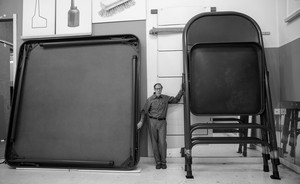

In honor of the extraordinary life of Robert Therrien (1947–2019), Aimee Gabbard writes about her time with the artist and explores his lifelong interest in photography.
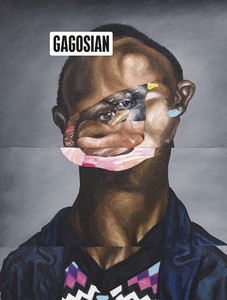
The Fall 2019 issue of Gagosian Quarterly is now available, featuring a detail from Sinking (2019) by Nathaniel Mary Quinn on its cover.
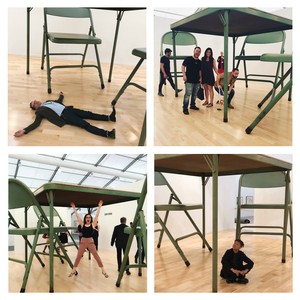
Robert Therrien’s investigations of form, perception, and subjectivity often isolate recognizable elements and objects from everyday life. Blake Gopnik challenges the traditional readings of transformation and the purpose of scale in Therrien’s No title (folding table and chairs, green).
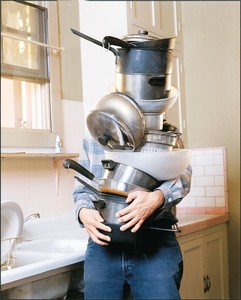
Alexander Wolf discusses the recurring themes and symbols that have emerged throughout Robert Therrien’s artistic career.
Request more information about
Robert Therrien